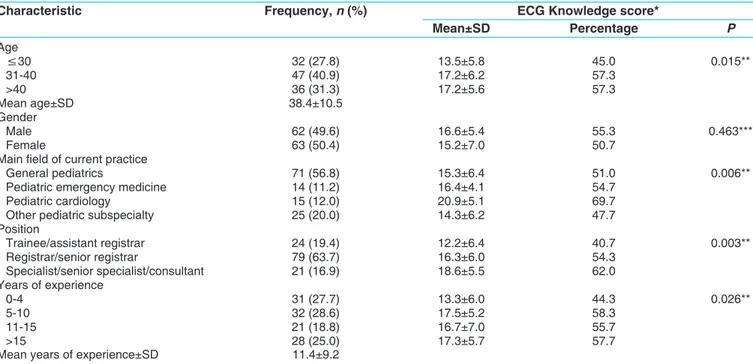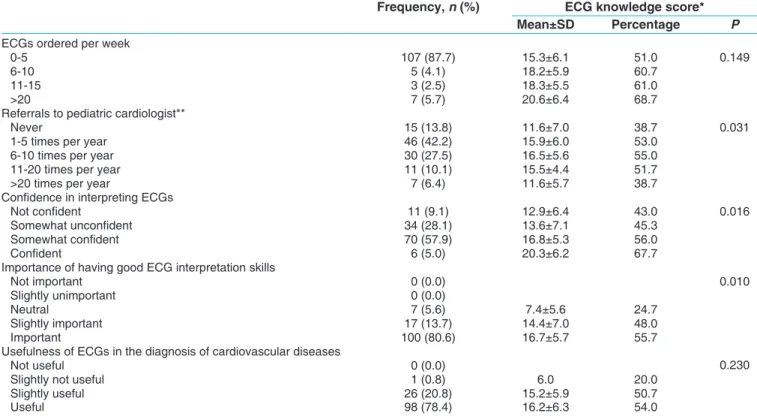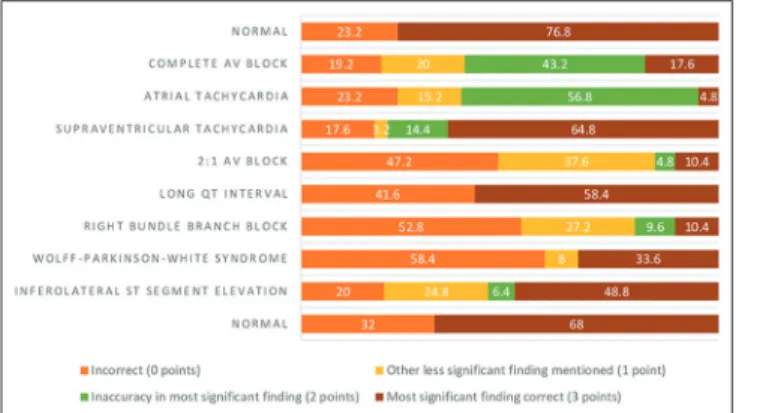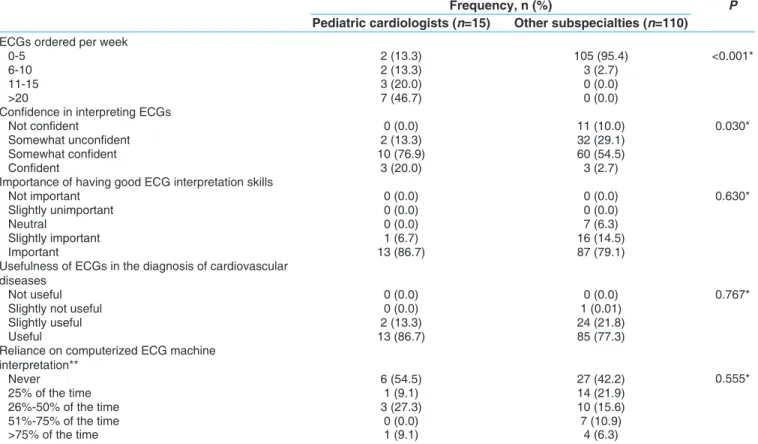Address for correspondence: Dr. Mohammad Ebrahim, Department of Pediatrics, Faculty of Medicine, Kuwait University, Jabriya, Block 4, Street 102, Postal Office 46300, Kuwait City, Kuwait. E-mail: mohammad.ibrahim@hsc.edu.kw
Submitted: 01-Feb-2020 Revised: 17-Mar-2020 Accepted: 05-Apr-2020 Published: 02-Jul-2020
Electrocardiogram interpretation among pediatricians: Assessing
knowledge, attitudes, and practice
Mohammad A Ebrahim
1, Reem K Alseid
2, Raghad T Aleinati
2, Volkan Tuzcu
3,41Department of Pediatrics, Faculty of Medicine, Kuwait University, Jabriya, Kuwait, 2Department of Pediatrics, Faculty of Medicine, Kuwait University,
Jabriya, Kuwait, 3Sidra Medicine, Heart Center, Doha, Qatar, 4Istanbul Medipol University Hospital, Division of Pediatric Cardiology, Istanbul, Turkey
ABSTRACT
Objectives : This study assesses the competency of pediatricians in interpreting electrocardiograms (ECGs).
Methods : A cross‑sectional study involving 125 pediatricians comprised of 71 general pediatricians, 15 pediatric cardiologists, and 39 other subspecialists recruited from all public hospitals and two specialty centers. Participants completed a questionnaire that included 10 ECGs and questions regarding backgrounds, attitudes, and practices. The ECGs were graded to obtain a knowledge score out of 30 points. Mann–Whitney U test and Kruskal‑Wallis test with post hoc analysis and Bonferroni adjustment were
used to compare groups.
Results : The mean knowledge score ranged from 47.7% to 69.7% among various pediatric specialties (P = 0.006). Age, increasing years of experience, confidence level,
number of cardiology referrals, and perceived importance of having good ECG interpretation skills were significantly related to the knowledge score (P ≤ 0.05).
Accuracy was highest in identifying normal ECGs (76.8%), supraventricular tachycardia (64.8%), along with long QT interval (58.4%), and was lowest for right bundle branch block (RBBB) (10.4%), 2:1 atrioventricular conduction (10.4%), and atrial tachycardia (AT) (4.8%). Accuracy among pediatric cardiologists was highest for long QT interval (100%), normal ECG (80%), as well as Wolff‑Parkinson‑White syndrome (80%), and lowest for RBBB (13.3%) and AT (0%). Most pediatricians believe that ECGs are “useful” (78.4%) and that having good interpretation skill is “important” (80.6%).
Conclusions : Pediatricians recognize the importance of ECGs. However, their skill and level of accuracy at interpretation is suboptimal, including cardiologists, and may affect patient care. Thus, efforts should be made to improve ECG understanding to provide better service to patients.
Keywords : Electrocardiogram, interpretation, pediatric cardiologists, pediatrician
Access this article online
Quick Response Code: Website:
www.annalspc.com DOI:
10.4103/apc.APC_18_20
This is an open access journal, and articles are distributed under the terms of the Creative Commons Attribution-NonCommercial-ShareAlike 4.0 License, which allows others to remix, tweak, and build upon the work non-commercially, as long as appropriate credit is given and the new creations are licensed under the identical terms.
For reprints contact: reprints@medknow.com
How to cite this article: Ebrahim MA, Alseid RK, Aleinati RT, Tuzcu V.
Electrocardiogram interpretation among pediatricians: Assessing knowledge, attitudes, and practice. Ann Pediatr Card 2020;13:205-11.
Diseases Hospital (CDH) and pediatric hematology/ oncology specialists from the National Bank of Kuwait Children’s Hospital were also included. All pediatricians encountered were invited to participate. The participating pediatricians were sampled by convenience. Several visits were taken to each hospital, where pediatricians from the wards, doctors’ and emergency rooms were invited to participate. They were given clear instructions to answer the questionnaires independently.
Questionnaire
The data collection tool consisted of a questionnaire that was divided into 3 parts: General background information, attitudes towards ECGs plus their relevance as a diagnostic tool, and ECG interpretation. The first section inquired about the participant’s age, gender, main field of practice, years of experience, and current position. In the second part, information regarding frequency of ordering ECGs, reliance on computerized interpretation, referrals to cardiology, participant’s confidence, the importance of ECGs, and the most common indication for ordering ECGs were assessed as well. The final part of the questionnaire consisted of 10 ECGs, two of which were normal. The ECGs were selected based on commonly encountered or potentially serious findings. The list of findings on the provided ECGs were as follows:
1. Normal
2. Complete heart block (CHB) 3. Atrial tachycardia (AT)
4. Supraventricular tachycardia (SVT) 5. 2:1 heart block
6. Long QT interval
7. Right bundle branch block (RBBB) 8. Wolff-Parkinson-White Syndrome (WPW) 9. ST Elevation in inferior leads
10. Normal.
The original ECGs were collected from patients’ files at CDH, scanned, and then printed in color to ensure a good resolution. The ECGs were deidentified, with the exception of the patient’s ages, to protect patient confidentiality. Participants were required to mention the abnormalities, if any, for each ECG provided.
Electrocardiogram interpretation knowledge score
The correct interpretation of the ECGs was obtained by consensus of two pediatric electrophysiologists among the authors (ME and VT). The ECGs were graded based on specific criteria in order to obtain a knowledge score out of 30 points, which was then converted to a percentage [Table 1]. Each ECG interpretation was awarded a maximum of three points.Statistical analysis
The data was processed using IBM Statistical Package for Social Science (SPSS) statistics version 26 ( BM Corporation, Armonk, NY, USA). Frequencies were used
INTRODUCTION
The electrocardiogram (ECG) is an invaluable diagnostic tool for cardiac disorders. Its widespread availability, noninvasive nature, and immediate results have rendered the ECG a vital tool in the workup of many conditions. Obtaining and correctly interpreting an ECG can facilitate early intervention with more appropriate management and timed referral.[1] Specifically, ECGs provide insight
into cardiac structural abnormalities, ischemic changes, electrolyte disturbances, channelopathies, and are important in the clearance for specific job positions, including some athletes prior to sport participation.[2-4]
Accuracy of electrocardiogram interpretation
Few studies have attempted to assess the accuracy of pediatricians’ interpretation of ECGs. A Canadian study evaluating ECG interpretation among general pediatricians found only 56% ± 20% accuracy in identifying a specific ECG abnormality.[4] Other studies presented differing
accuracies between subspecialties; for example, Giuffre et al. found that ECG interpretation among pediatric emergency physicians was fairly inaccurate when compared with pediatric cardiologists.[5] While these studies
have yielded a wide range of results, there seems to be a general consensus regarding the need for improvement in ECG interpretation qualities. Yet, information on ECG interpretation among general pediatricians and other pediatric subspecialties is deficient.
Attitudes towards electrocardiograms
According to Escudero et al., self-reported confidence in ECG interpretation positively correlated with accuracy in interpreting ECGs (P = 0.012).[4] Otherwise, there seems
to be limited data studying physicians’ opinions on ECG usefulness and importance, particularly in the field of pediatrics.
Objectives
The primary objective of this study was to assess the accuracy of ECG interpretation among pediatricians. The study also aimed to assess the attitudes and practices of pediatricians across various subspecialties as they relate to ECG usefulness, confidence in interpretation, frequency of use, and the main indications for ECG requests.
METHODS
Study design and data collection
This is a cross-sectional study conducted between June 19th and August 19th, 2019. Participants from the
seven general hospitals in Kuwait included general pediatricians, emergency physicians, nephrologists, neurologists, endocrinologists and intensive care doctors. Additionally, pediatric cardiologists from Chest
to summarize categorical variables, whereas mean and standard deviation were used to summarize continuous variables. Mann–Whitney U test and Kruskal-Wallis test with post hoc analysis and Bonferroni adjustment were used, as appropriate, to compare groups in terms of ECG knowledge score. With these tests, a P < 0.05 was considered significant.
Ethical considerations
Ethical approval was obtained through the Ministry of Health and Kuwait University Health Science Center ethical committees. Pediatricians participating in the study signed a written informed consent form, which was kept separate from the answered questionnaires in order to ensure confidentiality.
RESULTS
There was a participation rate of 69.4%, whereby 125 agreed out of 180 approached. The majority of
participants were general pediatricians (56.8%), with the mean age of 38.4 ± 10.5 years, and mean years of experience at 11.4 years [Table 2].
Age, increasing years of experience, confidence level, number of cardiology referrals, and perceived importance of ECGs interpretation skills were significantly related to the knowledge score [Tables 2 and 3].
The primary field of current practice was associated with the knowledge score (P = 0.006) [Table 2]. Those primarily working in pediatric cardiology, with a mean score of 20.9 ± 5.1, had significantly higher scores than those in other subspecialties, who had a mean score of 15.2 ± 6.1 (P = 0.001) [Table 4]. Working in the field of pediatric emergency medicine, however, did not yield significantly different knowledge scores than working in other subspecialties [Table 4].
The majority of participants (78.4%) believed that ECGs are useful in diagnosing cardiovascular diseases [Table 3]. Additionally, 45.2% of participants who have access to automated ECG interpretation reported that they never rely on them. However, both were not significantly associated with knowledge score.
Participants were asked to mark three indications from a given list that they believe to be the most important indications for ordering an ECG. “Palpitations” was selected by 81.6%, “syncope” by 73.6%, “chest pain” by 64.0%, “investigating a murmur” by 55.2%, “family history of cardiac diseases” by 20.8%, “prior to stimulant use for attention deficit hyperactivity disorde” by 4.8%, and “eating disorder” by 2.4%.
Table 1: Criteria for scoring of participants’
electrocardiogram interpretations
Points Description 0 points Incorrect interpretation
1 point Identified correct findings but failed to identify main abnormality (eg., failed to mention inferolateral ST segment elevation but mentions a co-existing sinus bradycardia)
2 points Identified main abnormality but with some degree of inaccuracy (eg., inaccuracy in mentioning the type of heart block)
3 points Identified main abnormality accurately
Table 2: Demographic characteristics of pediatricians working in public hospitals and associated ECG
knowledge score
Characteristic Frequency, n (%) ECG Knowledge score*
Mean±SD Percentage P Age ≤30 32 (27.8) 13.5±5.8 45.0 0.015** 31-40 47 (40.9) 17.2±6.2 57.3 >40 36 (31.3) 17.2±5.6 57.3 Mean age±SD 38.4±10.5 Gender Male 62 (49.6) 16.6±5.4 55.3 0.463*** Female 63 (50.4) 15.2±7.0 50.7
Main field of current practice
General pediatrics 71 (56.8) 15.3±6.4 51.0 0.006**
Pediatric emergency medicine 14 (11.2) 16.4±4.1 54.7
Pediatric cardiology 15 (12.0) 20.9±5.1 69.7
Other pediatric subspecialty 25 (20.0) 14.3±6.2 47.7
Position Trainee/assistant registrar 24 (19.4) 12.2±6.4 40.7 0.003** Registrar/senior registrar 79 (63.7) 16.3±6.0 54.3 Specialist/senior specialist/consultant 21 (16.9) 18.6±5.5 62.0 Years of experience 0-4 31 (27.7) 13.3±6.0 44.3 0.026** 5-10 32 (28.6) 17.5±5.2 58.3 11-15 21 (18.8) 16.7±7.0 55.7 >15 28 (25.0) 17.3±5.7 57.7
Mean years of experience±SD 11.4±9.2
Our questionnaire presented two normal ECGs; 76.8% and 68% were categorized correctly by noncardiologists [Figure 1]. Similarly, 80% and 66.7% were accurately labeled by cardiologists [Figure 2]. CHB was correctly identified by merely 17.6% of noncardiologists [Figure 1], whereas 60% of cardiologists properly classified this finding [Figure 2]. As for the 2:1 atrioventricular (AV) block, only 10.4% of noncardiologists recognized it [Figure 1]; in contrast to 53.3% of cardiologists [Figure 2]. While all pediatric cardiologists noted the long QT interval [Figure 2], only 58.4% of noncardiologists appropriately distinguished this finding [Figure 1].
AT was identified among 4.8% of noncardiologists [Figure 1], while no cardiologist was able to recognize it [Figure 2]. SVT was accurately identified in about 65%
in both groups [Figures 1 and 2]. Remarkably, <15% of all participants noted the RBBB [Figures 1 and 2]. Moreover, WPW syndrome was classified by 33.6% of noncardiologists [Figure 1], but conversely documented by 80% of cardiologists [Figure 2].
DISCUSSION
This study assessed for the ability to identify a wide range of ECG abnormalities in pediatric patients. The mean knowledge score of the entire sample was suboptimal. This is concerning considering the importance and frequent use of such a test to help diagnose and monitor various and serious conditions.
The entire sample scored poorly on the ECGs depicting CHB, 2:1 conduction, RBBB and AT [Figures 1 and 2].
Table 4: Knowledge score in electrocardiogram interpretation in association with certain subspecialties
in pediatrics
Frequency, n (%) ECG knowledge score
Mean±SD Percentage P Pediatric cardiology Pediatric cardiologists 15 (12) 20.9±5.1 69.7 0.001* Other subspecialties 110 (88) 15.2±6.1 50.7 Pediatric EM Pediatric EM physicians 14 (11.2) 16.4±4.1 54.7 0.906* Other subspecialties 111 (88.8) 15.9±6.5 53.0
*Mann–Whitney U-test. EM: Emergency Medicine, SD: Standard deviation, ECG: Electrocardiogram
Table 3: Practice and attitudes towards electrocardiograms among pediatricians and associated
electrocardiogram knowledge score
Frequency, n (%) ECG knowledge score*
Mean±SD Percentage P
ECGs ordered per week
0-5 107 (87.7) 15.3±6.1 51.0 0.149
6-10 5 (4.1) 18.2±5.9 60.7
11-15 3 (2.5) 18.3±5.5 61.0
>20 7 (5.7) 20.6±6.4 68.7
Referrals to pediatric cardiologist**
Never 15 (13.8) 11.6±7.0 38.7 0.031
1-5 times per year 46 (42.2) 15.9±6.0 53.0
6-10 times per year 30 (27.5) 16.5±5.6 55.0
11-20 times per year 11 (10.1) 15.5±4.4 51.7
>20 times per year 7 (6.4) 11.6±5.7 38.7
Confidence in interpreting ECGs
Not confident 11 (9.1) 12.9±6.4 43.0 0.016
Somewhat unconfident 34 (28.1) 13.6±7.1 45.3
Somewhat confident 70 (57.9) 16.8±5.3 56.0
Confident 6 (5.0) 20.3±6.2 67.7
Importance of having good ECG interpretation skills
Not important 0 (0.0) 0.010
Slightly unimportant 0 (0.0)
Neutral 7 (5.6) 7.4±5.6 24.7
Slightly important 17 (13.7) 14.4±7.0 48.0
Important 100 (80.6) 16.7±5.7 55.7
Usefulness of ECGs in the diagnosis of cardiovascular diseases
Not useful 0 (0.0) 0.230
Slightly not useful 1 (0.8) 6.0 20.0
Slightly useful 26 (20.8) 15.2±5.9 50.7
Useful 98 (78.4) 16.2±6.3 54.0
Figure 2: Scoring of the interpretation of ten 12‑lead electrocardiograms among pediatric cardiologists working in public hospitals
In comparison, a study on general pediatricians in Canada demonstrated that 67% correctly recognized CHB.[4] Unexpectedly, in this study, cardiologists’ level
of accuracy in interpreting such types of AV block was rather insufficient as pacemaker implantation might be warranted to avoid life threatening bradycardia.[6]
Surprisingly, only a minority of participants recognized the RBBB ECG. This is likely due to the absent rSR’ pattern in V1, which instead had a qR pattern. However, there was clear slurring of the S wave in V6, indicating terminal conduction delay, which is typical for RBBB (ECG number 7). Regarding the AT ECG, around half of the entire group described this ECG as sinus tachycardia or just stated ‘tachycardia’ [Figures 1 and 2]. Failure to recognize AT and P wave axis abnormalities can lead to significant morbidity and mortality from tachycardia-induced cardiomyopathy. This patient had negative P waves in leads I and aVL with PR interval at 120 msonds, all suggestive of ectopic AT (ECG number 3). Findings that were not adequately identified by the noncardiologist group which could have serious consequences include WPW, and long QT interval. General pediatricians also failed to identify both findings adequately in other studies.[4] Failure to
identify these patients places them at risk for sudden cardiac death if left untreated.[7] The ECG depicting
long QT interval showed pronounced QTc of more than 600 msonds, and yet it was missed by many noncardiologists (ECG number 6). In fact, this patient had frequent syncopal episodes due to nonsustained Torsades de pointes.
Inferolateral ST segment elevation was identified only by around half of the participants. Although this finding is infrequently encountered in this age group, it could potentially signify active ischemia, potentially due to coronary congenital anomaly, and would require prompt intervention.
Regarding the two normal ECGs presented, their suboptimal recognition can lead to unnecessary referrals
and diagnostic procedures, resulting in a waste of effort, time, and resources.
In a study by Giuffre et al., pediatric cardiologists had a high rate of interrater agreement.[5] This is not the
case in this study as the standard deviation is fairly wide (5.1 points) [Table 2]. Although this is partly explained by the small sample size, interpretations should be relatively consistent. In contrast to the study by Giuffre et al.,[5] a systematic review revealed a high
level of discrepancy among cardiologists but not among electrophysiologists.[8]
In terms of practice and attitudes towards ECGs, pediatric cardiologists were significantly more confident in their interpretation than other participants (P = 0.030) [Table 5]. In a similar manner, Begg et al. found that all cardiologists in their study were “fairly” or “very” comfortable compared to less than half of primary care physicians.[1]
Almost all of the participants (>90%) found ECG interpretation skills at least “slightly useful” [Table 3]. This ought to be an incentive to strengthen such skills. There is evidence to suggest that ECG interpretation can be improved through postgraduate training programs. A French study demonstrated that ECG interpretation scores improved by 15% (P = 0.0002) after assigning emergency medicine residents to an e-learning or a lecture-based course.[9] A UK-based study found that after
E-mailing pediatricians an online survey-study module, accuracy improved from 61.5% to 73.3%.[10]
Recommendations
Residency programs should emphasize ECG interpretation during training, as well as to facilitate workshops, lectures, or online modules dedicated to ECG interpretation. Some residency programs do not formally assess residents on their competency in interpretation.[11] Postgraduate
continual ECG training should be encouraged, such as routine scheduled talks or online video lectures.
Figure 1: Scoring of the interpretation of ten 12‑lead electrocardiograms among pediatricians working in public hospitals
Limitations
One limitation of the study is that the ECGs did not include clinical background information which may be provided in real hospital settings. This extra information is often helpful for more accurate diagnosis. Another limitation was the 69.4% participation rate. Although assessing reasons for refusal to participate was beyond the scope of this study, this may have been a source of bias, as those who refused to participate may lack confidence and competence. Furthermore, despite clear instructions to complete the questionnaire alone, physicians may still have discussed the ECGs or referred to the internet. Moreover, the study did not investigate the reasons behind the poor ECG knowledge scores, nor did it try to find associations between poor knowledge score and respective training programs structure and specifics.
CONCLUSIONS
ECGs are useful diagnostic tools that are invaluable in assessing cardiac disturbances. It has become first-line tests when cardiac conditions are suspected, and it is vital that pediatricians from all fields be competent in evaluating ECGs. However, this study has shown the
need for improvement in ECG interpretation accuracy among pediatricians, including pediatric cardiologists. Fortunately, this report has indicated that pediatricians in general have a positive attitude towards ECGs and believe in their importance in diagnosing cardiac conditions, which creates an opportunity for educational programs.
Financial support and sponsorship
Nil.Conflicts of interest
There are no conflicts of interest.
REFERENCES
1. Begg G, Willan K, Tyndall K, Pepper C, Tayebjee M. Electrocardiogram interpretation and arrhythmia management: A primary and secondary care survey. Br J Gen Pract 2016;66:e291-6.
2. Rosiek A, Leksowski K. The risk factors and prevention of cardiovascular disease: The importance of electrocardiogram in the diagnosis and treatment of acute coronary syndrome. Ther Clin Risk Manag 2016;12:1223-9.
3. Corrado D, Pelliccia A, Bjørnstad HH, Vanhees L, Biffi A, Borjesson M, et al. Cardiovascular pre-participation
Table 5: Practice and attitudes towards electrocardiograms among the participating pediatric cardiology
physicians
Frequency, n (%) P
Pediatric cardiologists (n=15) Other subspecialties (n=110) ECGs ordered per week
0-5 2 (13.3) 105 (95.4) <0.001*
6-10 2 (13.3) 3 (2.7)
11-15 3 (20.0) 0 (0.0)
>20 7 (46.7) 0 (0.0)
Confidence in interpreting ECGs
Not confident 0 (0.0) 11 (10.0) 0.030*
Somewhat unconfident 2 (13.3) 32 (29.1)
Somewhat confident 10 (76.9) 60 (54.5)
Confident 3 (20.0) 3 (2.7)
Importance of having good ECG interpretation skills
Not important 0 (0.0) 0 (0.0) 0.630*
Slightly unimportant 0 (0.0) 0 (0.0)
Neutral 0 (0.0) 7 (6.3)
Slightly important 1 (6.7) 16 (14.5)
Important 13 (86.7) 87 (79.1)
Usefulness of ECGs in the diagnosis of cardiovascular diseases
Not useful 0 (0.0) 0 (0.0) 0.767*
Slightly not useful 0 (0.0) 1 (0.01)
Slightly useful 2 (13.3) 24 (21.8)
Useful 13 (86.7) 85 (77.3)
Reliance on computerized ECG machine interpretation** Never 6 (54.5) 27 (42.2) 0.555* 25% of the time 1 (9.1) 14 (21.9) 26%-50% of the time 3 (27.3) 10 (15.6) 51%-75% of the time 0 (0.0) 7 (10.9) >75% of the time 1 (9.1) 4 (6.3)
*Fisher’s exact test, **Among those with access to automated ECG interpretation (11 pediatric cardiologists and 64 physicians in other subspecialties). ECGs: Electrocardiograms
screening of young competitive athletes for prevention of sudden death: Proposal for a common European protocol. Consensus Statement of the Study Group of Sport Cardiology of the Working Group of Cardiac Rehabilitation and Exercise Physiology and the Working Group of Myocardial and Pericardial Diseases of the European Society of Cardiology. Eur Heart J 2005;26:516-24.
4. Escudero CA, Sanatani S, Wong KK, Templeton CG. Electrocardiogram interpretation by Canadian general paediatricians: Examining practice, accuracy and confidence. Paediatr Child Health 2014;19:77-83. 5. Giuffre RM, Nutting A, Cohen J, Crawford S, Johnson DW.
Electrocardiogram interpretation and management in a pediatric emergency department. Pediatr Emerg Care 2005;21:143-8.
6. Baruteau AE, Pass RH, Thambo JB, Behaghel A, Le Pennec S, Perdreau E, et al. Congenital and childhood atrioventricular blocks: Pathophysiology and contemporary management. Eur J Pediatr 2016;175:1235-48.
7. Qiu M, Lv B, Lin W, Ma J, Dong H. Sudden cardiac death due to the Wolff-Parkinson-white syndrome: A case report with genetic analysis. Medicine (Baltimore) 2018;97:e13248.
8. Salerno SM, Alguire PC, Waxman HS. Competency in interpretation of 12-lead electrocardiograms: A summary and appraisal of published evidence. Ann Intern Med 2003;138:751-60.
9. Barthelemy FX, Segard J, Fradin P, Hourdin N, Batard E, Pottier P, et al. ECG interpretation in emergency department residents: An update and e-learning as a resource to improve skills. Eur J Emerg Med 2017;24:149-56.
10. Jheeta JS, Narayan O, Krasemann T. Republished: Accuracy in interpreting the paediatric ECG: A UK-wide study and the need for improvement. Postgrad Med J 2015;91:436-8.
11. Ginde AA, Char DM. Emergency medicine residency training in electrocardiogram interpretation. Acad Emerg Med 2003;10:738-42.



